The blogger visited a military theme park in Shenzhen, Minsk World, which features a recreated Soviet aircraft carrier. Nearby, they explored The Dawan Residence, a 1791 fort square Hakka site in Longgang district. The residence was designated as a protected historical site for its cultural significance and has remnants of firecrackers from the Chinese New Year celebration.
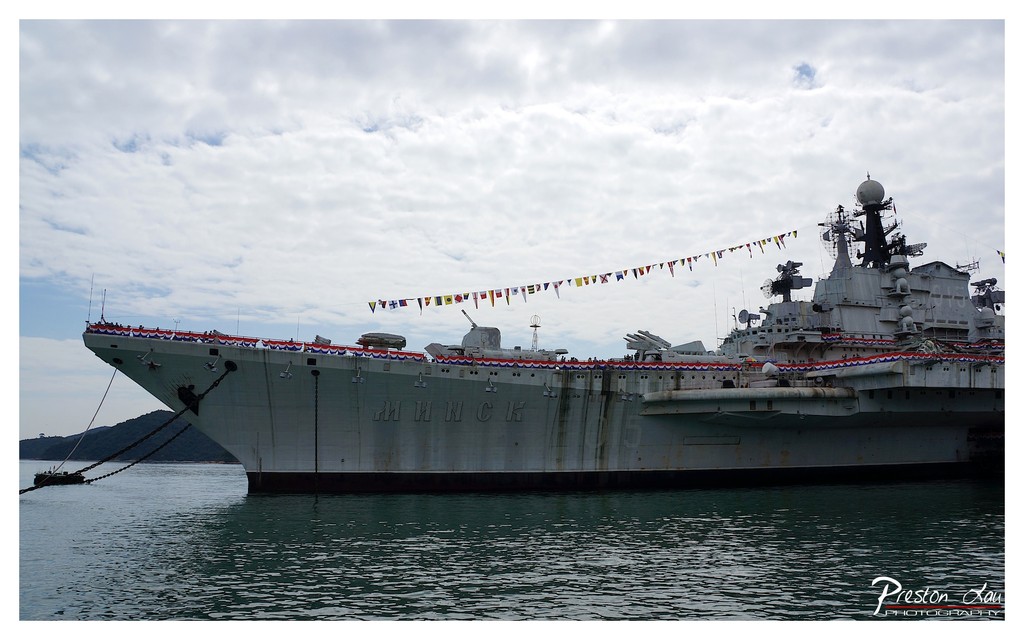

1. Overall Rating (0–10) — 7.0
This photograph captures the imposing presence of the Russian aircraft carrier *Minsk* in a state of quiet repose, its hull adorned with festive bunting that suggests a ceremonial occasion. The ship’s weathered surface and overcast sky lend a somber dignity to the scene, evoking both historical weight and a sense of transition. While the composition is strong and the subject compelling, the muted lighting and lack of dynamic contrast slightly diminish the image’s visual punch.
2. Composition (0–10) — 7.0
The ship is framed diagonally, creating a sense of movement and scale, with the bow leading the eye into the frame. The balance between the vessel, water, and sky is well-managed, though the cluttered superstructure slightly distracts from the clean lines of the hull.
3. Lighting (0–10) — 5.5
Diffuse, overcast lighting flattens the scene, softening shadows and reducing depth. While it evenly illuminates the ship, the lack of directional light diminishes the dramatic effect of the vessel’s form and texture.
4. Color & Tone (0–10) — 6.0
The palette is dominated by muted grays and blues, with the red, white, and blue of the bunting offering a subtle pop of color. The overall tone is subdued, reflecting the cloudy atmosphere, though the colors remain true without oversaturation.
5. Creativity (0–10) — 6.5
The image captures a moment of cultural and historical significance, with the festive decorations contrasting against the military machine. The choice to photograph the ship in a non-combat setting adds narrative depth, though the execution remains largely documentary.
6. Technical Quality (0–10) — 7.5
The photograph is sharp and clear, with fine detail visible on the ship’s hull and superstructure. The focus is consistent across the frame, and the exposure is well-balanced despite the challenging lighting.
7. Emotional Impact (0–10) — 6.5
The image evokes a contemplative mood, blending pride in national heritage with the melancholy of a vessel no longer in active service. The emotional resonance is grounded in context rather than visual drama, inviting reflection on history and change.
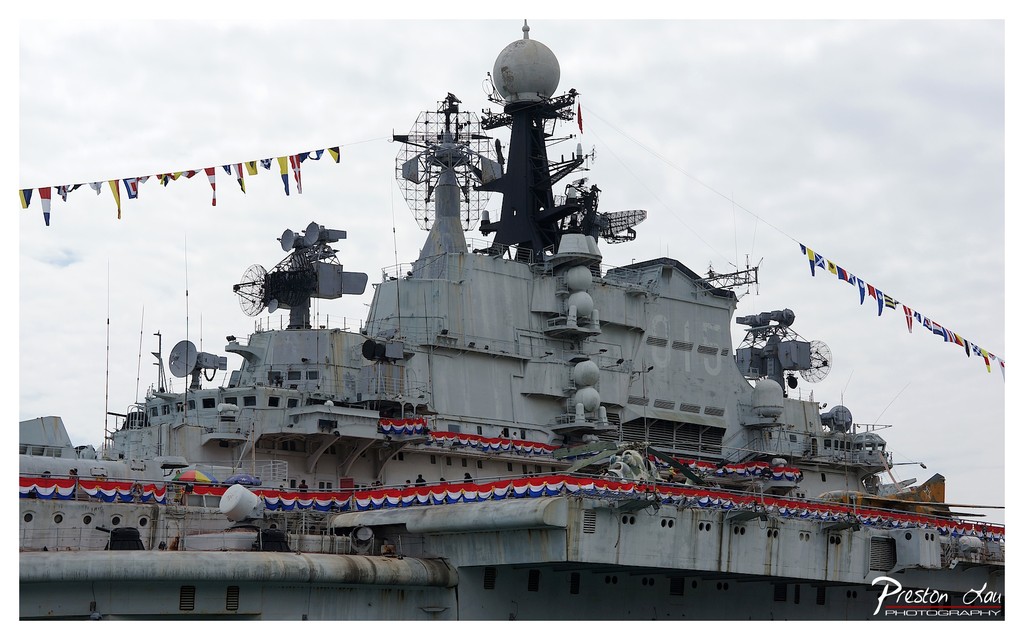

1. Overall Rating (0–10) — 7.0
This photograph captures the imposing presence of a naval vessel during what appears to be a ceremonial occasion, with vibrant bunting and signal flags adding a celebratory contrast to the industrial scale of the ship. The composition emphasizes the ship’s complex array of radar and communication systems, suggesting both power and technological sophistication. While the overcast sky dampens the overall mood, the strategic use of color and detail gives the image a compelling, documentary-like energy.
2. Composition (0–10) — 6.5
The framing centers on the ship’s superstructure, creating a strong visual anchor, but the low angle and cluttered foreground slightly disrupt the balance. The diagonal lines of the signal flags add dynamic movement, though they compete for attention with the ship’s intricate details.
3. Lighting (0–10) — 5.5
The diffused light from the overcast sky provides even illumination, minimizing harsh shadows and allowing for clear visibility of the ship’s features. However, the lack of directional light results in a flat, muted atmosphere that diminishes the dramatic impact of the scene.
4. Color & Tone (0–10) — 7.0
The muted gray tones of the ship are effectively contrasted by the bold red, white, and blue of the bunting and flags, creating a visually engaging palette. The colors are vibrant enough to stand out without appearing artificial, enhancing the festive yet authoritative mood.
5. Creativity (0–10) — 7.5
The juxtaposition of military might and ceremonial festivity offers a compelling narrative. The photographer captures both the scale of the vessel and the cultural context of the event, creating a layered image that speaks to national pride and maritime tradition.
6. Technical Quality (0–10) — 8.0
The image is sharp and detailed, with clear focus on the ship’s superstructure and radar systems. The depth of field is appropriate, and the overall resolution is strong, allowing for fine texture and clarity in the metallic surfaces.
7. Emotional Impact (0–10) — 6.5
The photograph evokes a sense of awe at the scale of naval power, tempered by the celebratory elements that suggest pride and unity. While the overcast conditions limit emotional warmth, the image successfully conveys a moment of significance and ceremonial importance.
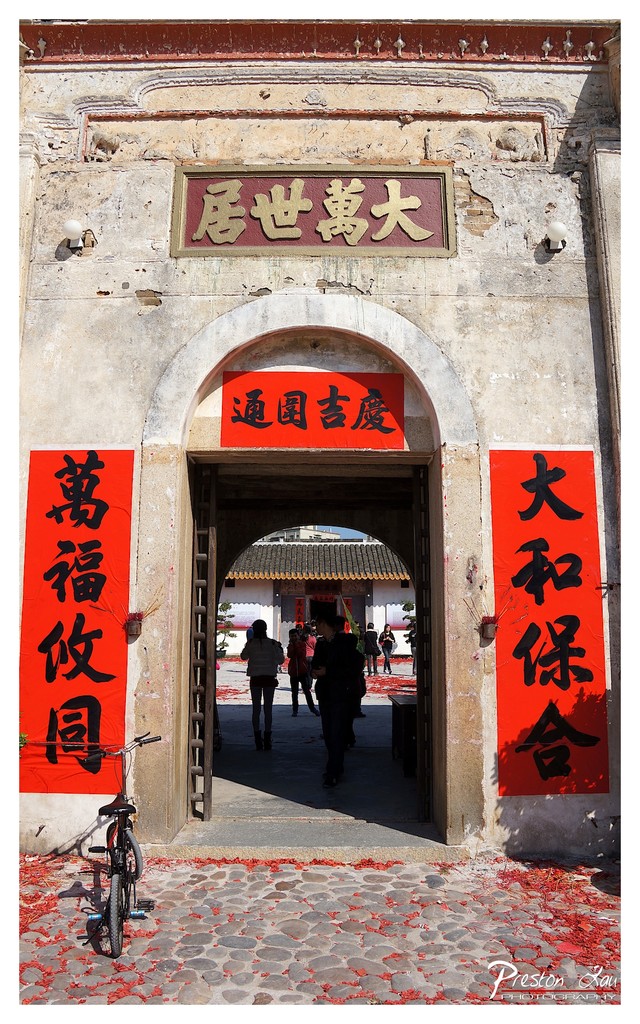

1. Overall Rating (0–10) — 7.5
This photograph captures a vibrant cultural moment at the entrance of a traditional Chinese temple or ancestral hall, where history and daily life converge. The bold red calligraphy, scattered firecracker remnants, and silhouetted figures create a dynamic sense of celebration and continuity. While the composition is strong and rich in cultural symbolism, the slightly harsh sunlight and uneven framing detract from the image’s overall visual harmony.
2. Composition (0–10) — 7.0
The arched gateway creates a natural frame, drawing the eye into the scene, while the symmetry of the red banners enhances balance. However, the placement of the bicycle in the lower-left corner slightly disrupts the visual flow, and the off-center subject placement adds a degree of asymmetry that feels unintentional.
3. Lighting (0–10) — 6.5
The bright, direct sunlight creates strong contrast, casting deep shadows within the archway and highlighting the texture of the weathered wall. While the light emphasizes the details of the architecture and the red banners, it also flattens the foreground and slightly overexposes the bright reds, reducing tonal depth.
4. Color & Tone (0–10) — 8.0
The dominant red and black of the calligraphy against the muted beige stone creates a powerful visual contrast. The warm tones of the aged wall and the scattered red firecracker debris add richness and cultural resonance. The color palette is bold and purposeful, enhancing the festive atmosphere.
5. Creativity (0–10) — 8.0
The image successfully blends architectural detail with human activity, capturing a moment of cultural tradition. The use of the arch as a natural frame and the inclusion of firecracker remnants suggest a recent celebration, adding narrative depth. The photograph feels both documentary and artistic, offering insight into local customs.
6. Technical Quality (0–10) — 7.5
The image is sharp and detailed, with clear focus on the central archway and text. The exposure is generally well-managed, though the high contrast between light and shadow results in some loss of detail in the highlights. The depth of field is appropriate, keeping the key elements in focus.
7. Emotional Impact (0–10) — 7.0
The photograph evokes a sense of community and tradition, with the silhouetted figures walking through the gate suggesting continuity and passage. The red firecrackers and calligraphy convey joy and auspiciousness, creating a feeling of celebration that resonates with cultural pride. The viewer is invited to imagine the sounds and stories within the courtyard.
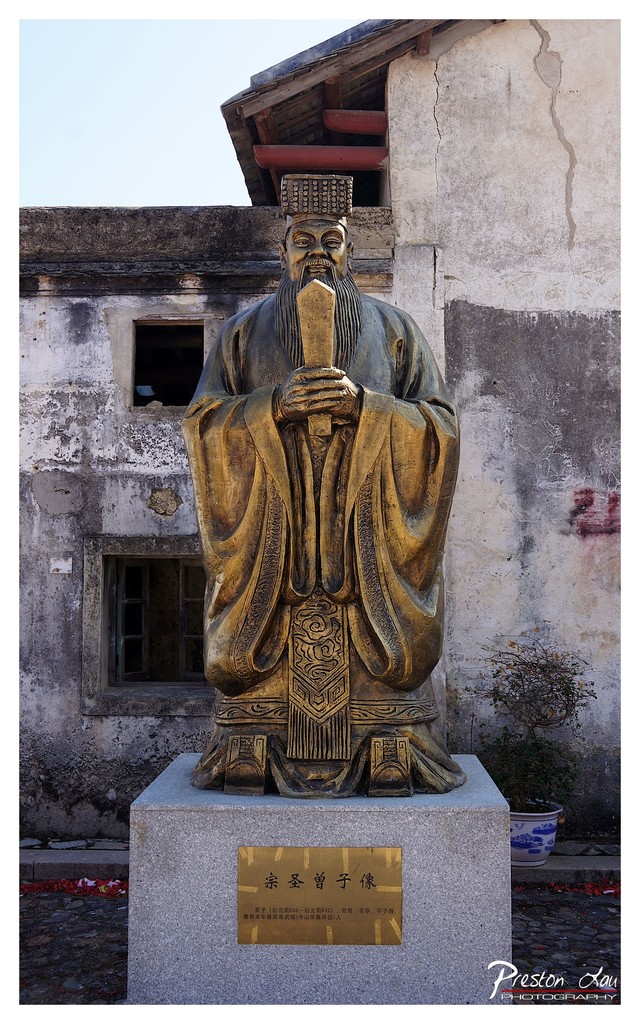

1. Overall Rating (0–10) — 7.0
This photograph captures the dignified presence of a golden statue of Confucius, standing as a cultural sentinel against the weathered backdrop of an old building. The contrast between the polished, ornate figure and the decaying architecture creates a compelling narrative of tradition enduring through time. While the image is visually strong and conceptually rich, the lighting and color balance slightly flatten the scene’s emotional depth.
2. Composition (0–10) — 7.5
The statue is well-centered and dominates the frame, creating a strong focal point. The aged wall and architectural details provide context without distracting, while the slight tilt of the building adds subtle dynamism. A tighter crop could enhance intimacy, but the current framing effectively conveys scale and setting.
3. Lighting (0–10) — 6.5
Natural daylight illuminates the scene evenly, highlighting the texture of the statue and the wall. However, the flatness of the light, particularly in the sky and shadows, reduces the sense of depth and drama. A more directional light source would have accentuated the statue’s contours and added visual interest.
4. Color & Tone (0–10) — 6.0
The golden hue of the statue contrasts with the muted grays and off-whites of the wall, creating a natural color harmony. The palette is restrained and authentic, though the overall tone feels slightly desaturated, dampening the vibrancy of the gold and diminishing the image’s warmth.
5. Creativity (0–10) — 7.0
The juxtaposition of the revered figure against a worn, lived-in setting is conceptually engaging. The photograph captures more than a likeness—it suggests a dialogue between history and decay, tradition and time. While not radically original, the narrative approach elevates it beyond a simple portrait.
6. Technical Quality (0–10) — 7.5
The image is sharp and well-focused, with clear detail in both the statue and the background textures. The exposure is balanced, and the resolution is high, allowing for fine visual information. The slight grain and edge softness in the sky suggest minimal post-processing, preserving authenticity.
7. Emotional Impact (0–10) — 6.5
The statue evokes a sense of reverence and contemplation, but the emotional resonance is tempered by the image’s clinical clarity. The viewer is invited to reflect on cultural continuity, yet the lack of atmospheric lighting and expressive mood keeps the connection somewhat intellectual rather than deeply felt.
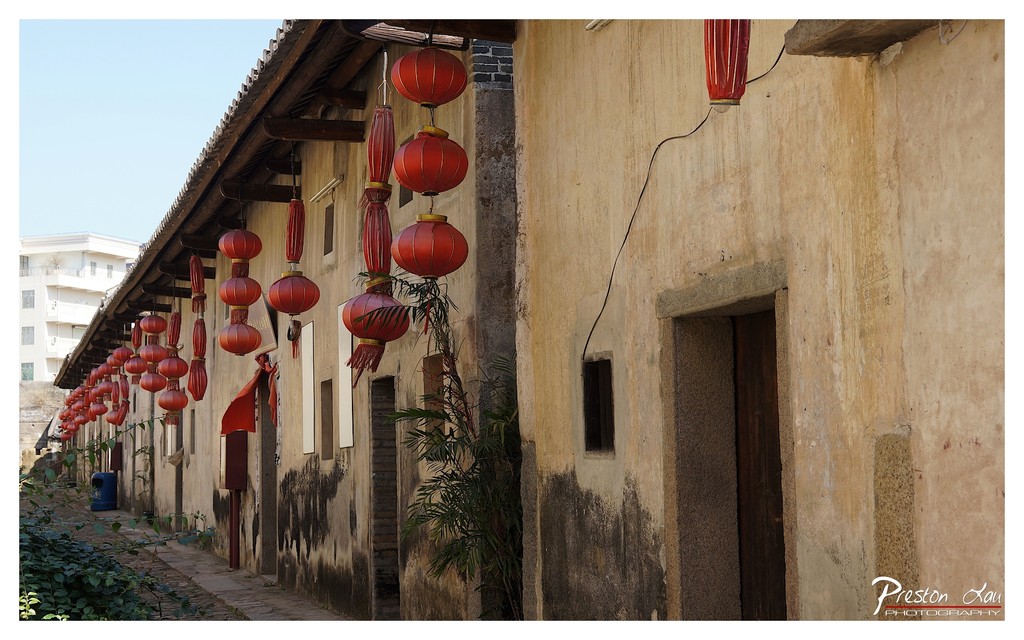

1. Overall Rating (0–10) — 7.0
This photograph captures a quiet, atmospheric alleyway in a traditional Chinese village, where the vibrant red lanterns offer a striking contrast against the weathered, earth-toned walls. The interplay of old architecture and subtle signs of modern life—like the distant high-rise and visible wiring—adds depth and narrative tension. While the image successfully evokes a sense of cultural continuity, its emotional resonance is slightly muted by a lack of dynamic lighting and compositional restraint.
2. Composition (0–10) — 7.5
The diagonal line of lanterns creates a strong leading line, guiding the eye through the frame and emphasizing the length of the alley. The placement of the doorway on the right balances the composition, while the overhanging eaves and textured walls add visual interest. The slightly off-center framing gives the image a natural, documentary feel, though tighter cropping might enhance focus.
3. Lighting (0–10) — 6.5
Natural daylight illuminates the scene evenly, preserving detail in the textures of the walls and lanterns. However, the light lacks directional warmth or dramatic shadows, resulting in a somewhat flat quality. The bright sky in the upper left introduces a slight overexposure, detracting from the overall tonal harmony.
4. Color & Tone (0–10) — 7.0
The warm, muted tones of the aged stucco and wood create a harmonious backdrop for the vivid red lanterns, which serve as a bold focal point. The color contrast enhances the cultural significance of the scene, while the cool blue of the distant building adds a subtle counterpoint. The overall palette is rich yet restrained, reinforcing the image’s contemplative mood.
5. Creativity (0–10) — 7.0
The photographer effectively captures a moment of cultural tradition within a changing environment, blending old and new in a visually compelling way. The choice to emphasize the lanterns as a repeating motif introduces rhythm and visual continuity, while the inclusion of modern elements adds narrative depth. The image feels both authentic and thoughtfully composed.
6. Technical Quality (0–10) — 8.0
The image is sharp and well-focused, with clear detail visible in the textures of the walls, lanterns, and foliage. The exposure is generally balanced, though minor overexposure in the sky suggests a slight technical limitation. The color reproduction is accurate and natural, enhancing the authenticity of the scene.
7. Emotional Impact (0–10) — 6.5
The photograph evokes a sense of nostalgia and quiet reverence for tradition, underscored by the aged architecture and symbolic lanterns. While the viewer is drawn into the scene, the emotional connection is tempered by the lack of human presence and the somewhat detached, observational framing. The image feels more like a historical record than a deeply personal moment.
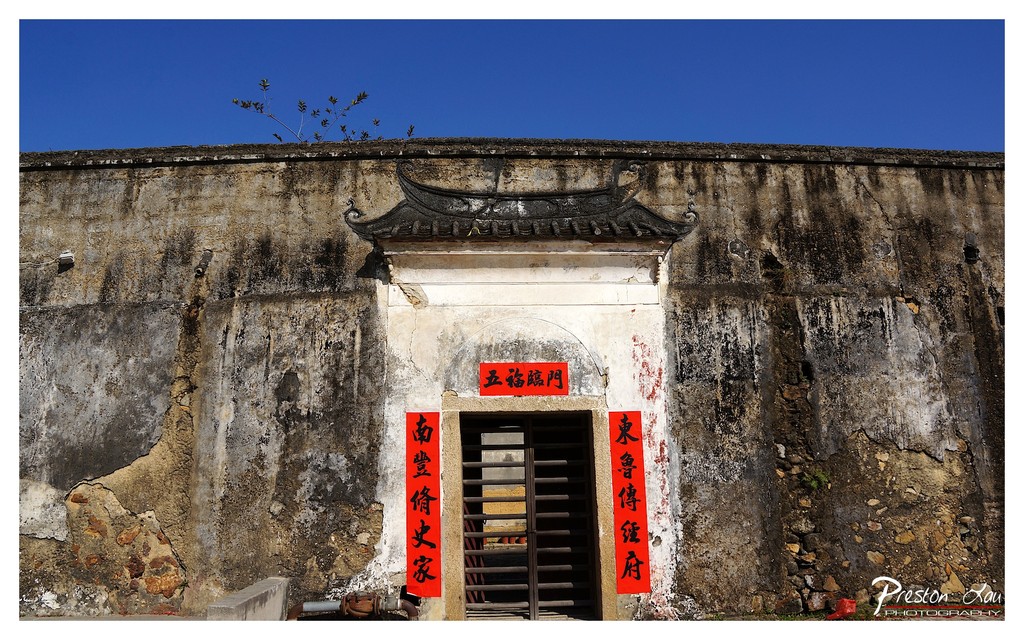

1. Overall Rating (0–10) — 7.5
This photograph captures the quiet dignity of a historic Chinese gate, where weathered stone and vibrant red banners create a striking contrast against a deep blue sky. The composition balances cultural detail with a sense of timelessness, while the bold colors and aged textures evoke both reverence and decay. Though the scene is rich in narrative, the lighting’s harshness slightly diminishes the emotional subtlety of the moment.
2. Composition (0–10) — 8.0
The central placement of the gate draws immediate attention, with the symmetrical red couplets enhancing visual harmony. The high-angle perspective emphasizes the wall’s scale, while the clear blue sky above provides strong negative space, grounding the subject with elegance.
3. Lighting (0–10) — 7.0
Strong, direct sunlight highlights the textures of the weathered wall and casts deep shadows, enhancing the sense of age. The bright illumination on the red banners makes them pop, though the harshness slightly flattens the mid-tones on the stone.
4. Color & Tone (0–10) — 8.0
The contrast between the deep blue sky, the earthy grays of the wall, and the bold red of the calligraphy creates a powerful and culturally resonant palette. The tones are rich and saturated, giving the image an almost ceremonial quality.
5. Creativity (0–10) — 7.5
The juxtaposition of ancient architecture and festive, contemporary elements like the red banners adds narrative depth. The photographer captures not just a structure, but a living tradition, suggesting continuity and identity.
6. Technical Quality (0–10) — 8.0
Sharp focus and clear detail across the frame, particularly in the calligraphy and textures of the wall, demonstrate strong technical control. The image is well-exposed, with no significant loss of detail in highlights or shadows.
7. Emotional Impact (0–10) — 7.0
The image evokes a quiet reverence for heritage and endurance, inviting the viewer to reflect on the passage of time. The red banners add a touch of warmth and celebration, softening the austerity of the stone and creating a sense of cultural pride.
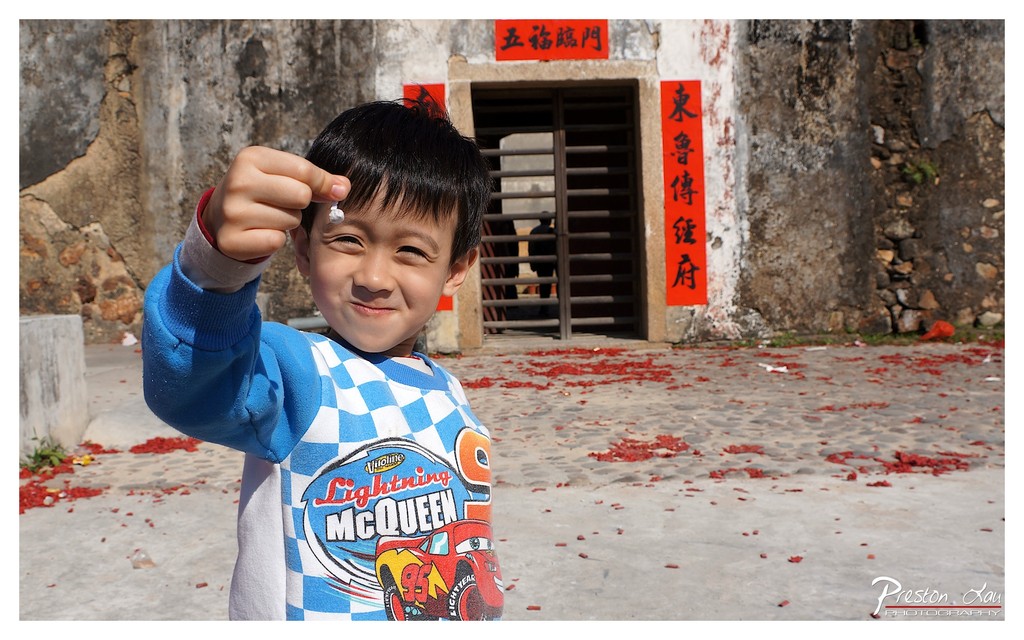

1. Overall Rating (0–10) — 7.5
This photograph captures a moment of joyful innocence, with a young boy proudly displaying a small object against the backdrop of a traditional Chinese gate. The vibrant red firecracker remnants and the child’s playful expression infuse the scene with cultural warmth and celebratory energy. While the composition is strong and the subject engaging, the slightly cluttered background and flat lighting keep the image from achieving a more refined aesthetic.
2. Composition (0–10) — 7.0
The boy is well-centered and occupies the foreground effectively, drawing immediate attention. The red banners and arched gate provide cultural context and depth, though the scattered debris on the ground adds visual noise that slightly distracts from the main subject.
3. Lighting (0–10) — 7.5
Bright, natural daylight illuminates the scene evenly, highlighting the boy’s features and the vivid colors of his clothing and the red firecracker paper. The light is direct, creating subtle shadows that enhance depth without overpowering the image.
4. Color & Tone (0–10) — 8.0
The contrast between the boy’s blue and white checkered shirt, the bright red firecracker remnants, and the weathered stone wall creates a rich, dynamic palette. The reds are especially vibrant, evoking festivity and tradition, while the muted tones of the architecture provide grounding contrast.
5. Creativity (0–10) — 7.5
The image blends candid emotion with cultural storytelling, capturing a genuine moment during what appears to be a celebration. The choice to include the traditional gate and firecracker debris adds narrative depth, making the photograph more than just a portrait—it becomes a cultural snapshot.
6. Technical Quality (0–10) — 8.0
The image is sharp and clear, with the subject in crisp focus. The depth of field is appropriate, keeping the boy distinct while softly blurring the background. The watermark is subtle and does not detract from the composition.
7. Emotional Impact (0–10) — 8.5
The boy’s wide smile and playful gesture evoke warmth and joy, creating an immediate emotional connection. The scene feels authentic and full of life, resonating with themes of childhood, tradition, and celebration.
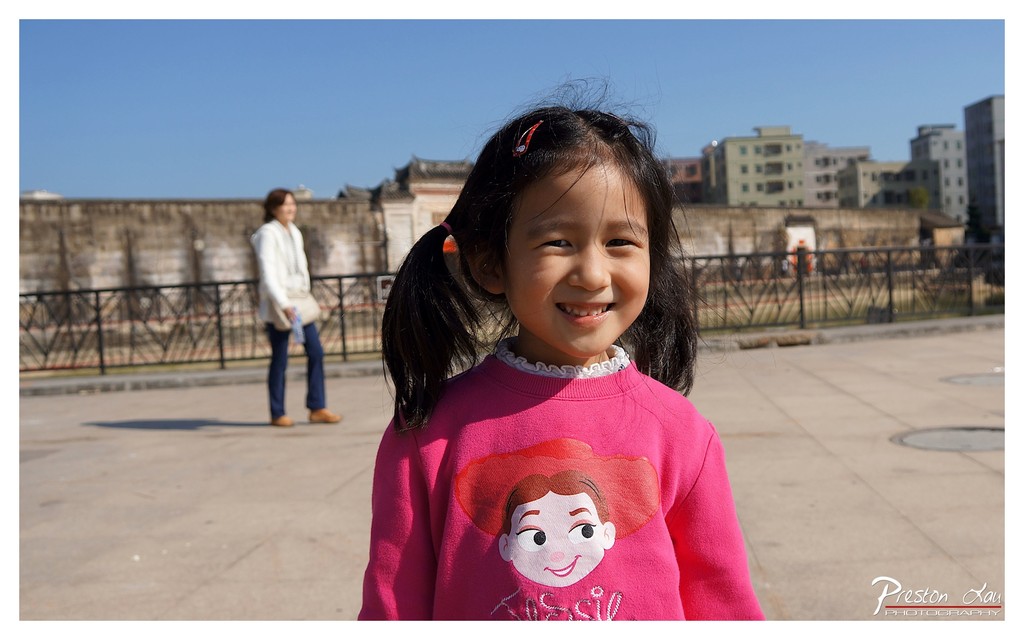

1. Overall Rating (0–10) — 7.5
This photograph captures a moment of pure, unguarded joy, with the young girl’s radiant smile serving as the emotional anchor of the scene. The contrast between her vibrant pink sweater and the muted tones of the background creates a striking visual focus, while the soft natural light enhances the warmth of the moment. Though the background is slightly distracting due to the presence of another figure and architectural elements, the image succeeds in conveying a sense of candid life and cultural context—its strength lies in its genuine emotion and narrative clarity.
2. Composition (0–10) — 7.0
The subject is well-placed in the foreground, drawing immediate attention, though the background figure and railing introduce visual noise. A tighter crop would further isolate the girl and enhance compositional harmony.
3. Lighting (0–10) — 8.0
Natural sunlight bathes the scene in bright, even light, highlighting the girl’s features and creating soft shadows that add depth. The clear blue sky provides a clean backdrop that complements the subject’s warmth.
4. Color & Tone (0–10) — 7.5
The rich pink of the sweater contrasts beautifully with the neutral tones of the pavement and the pale sky, while the overall palette remains balanced and visually pleasing. A slight increase in saturation could enhance the vibrancy of the colors.
5. Creativity (0–10) — 7.0
The image captures a spontaneous moment with a strong sense of place, blending cultural and personal elements. While not radically original in concept, its storytelling power lies in its authenticity and emotional resonance.
6. Technical Quality (0–10) — 8.5
The focus is sharp on the girl’s face, with clear detail in her features and clothing. The exposure is well-balanced, and the depth of field effectively separates the subject from the background.
7. Emotional Impact (0–10) — 8.5
The girl’s genuine smile and bright eyes evoke warmth and happiness, creating an immediate emotional connection. The viewer is drawn into her moment of joy, making the photograph deeply affecting and memorable.
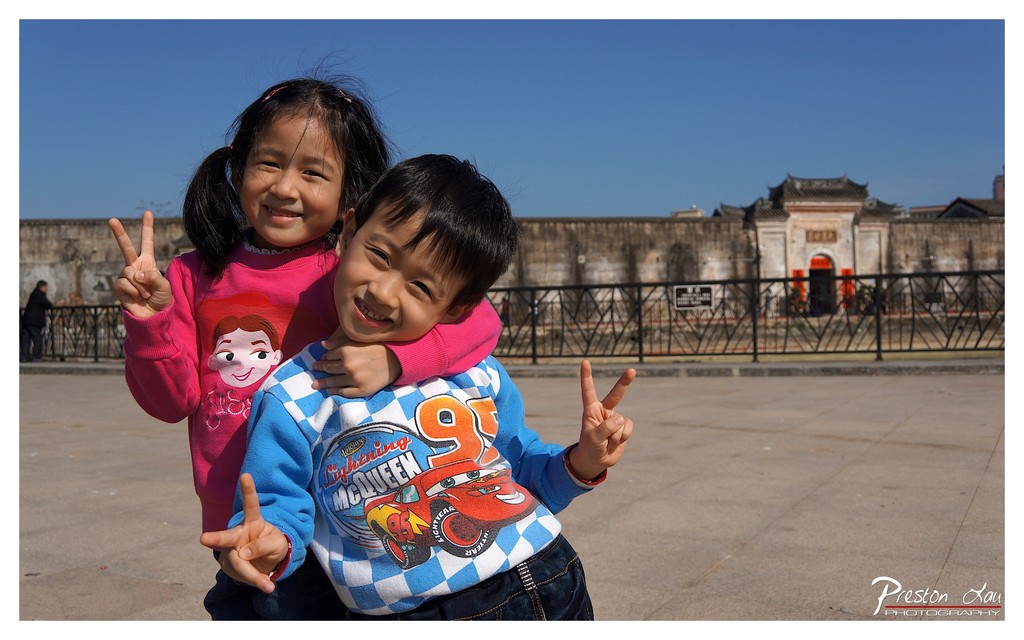

1. Overall Rating (0–10) — 7.5
This photograph captures a radiant moment of childhood joy, with two children radiating warmth and playfulness against a backdrop of historic architecture. Their genuine smiles and synchronized peace signs convey a sense of connection and carefree happiness. While the image is vibrant and full of life, the slightly cluttered background and overexposed sky reduce its overall visual harmony, keeping it from achieving true artistic refinement.
2. Composition (0–10) — 7.0
The children are well-centered and occupy the foreground with strong presence, drawing immediate attention. The framing includes enough negative space to avoid overcrowding, though the distant architectural elements slightly distract from the emotional core of the image.
3. Lighting (0–10) — 8.0
The bright, direct sunlight enhances the vividness of the children’s clothing and expressions, creating a cheerful, energetic mood. The shadows are sharp but not overly harsh, suggesting optimal midday light that illuminates the subjects clearly.
4. Color & Tone (0–10) — 8.5
The palette is rich and saturated, with bold pinks and blues on the children’s sweaters contrasting beautifully against the neutral tones of the stone wall and the deep blue sky. The high contrast and vibrancy give the image a lively, almost cinematic quality.
5. Creativity (0–10) — 7.5
The juxtaposition of youthful exuberance against a historic setting adds narrative depth, suggesting a story of heritage and innocence coexisting. The peace signs add a modern, playful touch that enhances the image’s emotional appeal.
6. Technical Quality (0–10) — 8.0
The focus is sharp on the children, capturing fine details in their clothing and facial expressions. The exposure is well-balanced on the subjects, though the sky is slightly overexposed, indicating a minor technical limitation.
7. Emotional Impact (0–10) — 9.0
The image radiates unfiltered joy and warmth, evoking a strong sense of nostalgia and affection. The children’s genuine connection and happiness are palpable, creating an instant emotional resonance with the viewer.
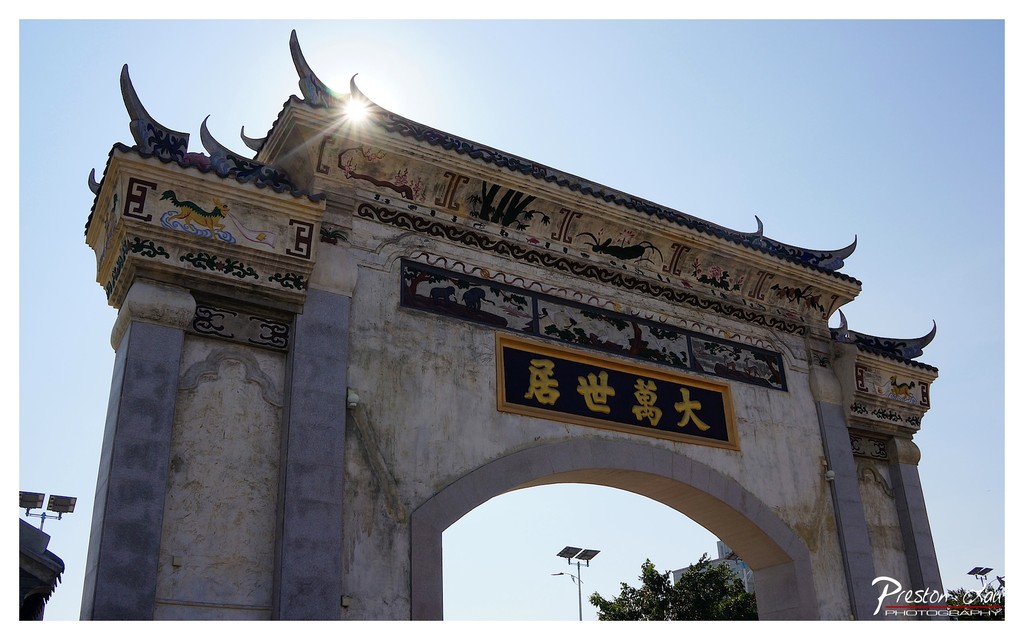

1. Overall Rating (0–10) — 7.0
This photograph captures the grandeur of a traditional Chinese archway under a clear sky, with the sun dramatically flaring through its ornate roofline. The low-angle perspective emphasizes the monument’s scale and cultural significance, while the interplay of light and shadow adds a sense of timelessness. The image is visually striking, though the sunburst slightly obscures details on the upper structure, and the composition’s slight asymmetry keeps it from feeling fully balanced.
2. Composition (0–10) — 6.5
The low-angle shot enhances the arch’s imposing presence, but the off-center sun flare and uneven framing of the structure create a subtle imbalance. A tighter crop might have improved visual harmony.
3. Lighting (0–10) — 8.0
The backlighting from the sun creates a radiant lens flare that draws the eye, enhancing the spiritual and dramatic mood. While it partially obscures details, the strong contrast between light and shadow adds depth and energy.
4. Color & Tone (0–10) — 6.5
The warm golden tones of the arch contrast with the cool blue sky, creating a pleasing natural palette. However, the overexposure from the sun slightly flattens the highlights, reducing tonal richness in the upper sections.
5. Creativity (0–10) — 7.5
The use of backlighting to highlight the arch’s silhouette and the intentional inclusion of the lens flare demonstrate a strong artistic vision. The image blends cultural documentation with expressive lighting, elevating it beyond a simple architectural portrait.
6. Technical Quality (0–10) — 8.0
Sharp focus on the arch and clean detail in the stonework show strong technical execution. The exposure is well-handled overall, though the flare is a trade-off for dramatic effect.
7. Emotional Impact (0–10) — 7.0
The image evokes a sense of reverence and awe, inviting the viewer to contemplate tradition and endurance. The radiant light and monumental scale stir a quiet emotional resonance, connecting the viewer to the cultural weight of the structure.
Loading map...